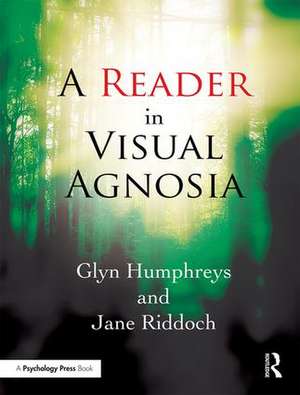A Reader in Visual Agnosia
Autor Glyn Humphreys, Jane Riddochen Limba Engleză Hardback – 17 dec 2015
The chapters are divided into 6 parts corresponding to the key areas of investigation:
- Integrative visual agnosia
- Perception of global form
- Face perception
- Colour perception
- Word recognition
- Changes over time
Preț: 1051.50 lei
Preț vechi: 1409.46 lei
-25% Nou
Puncte Express: 1577
Preț estimativ în valută:
201.21€ • 211.04$ • 167.50£
201.21€ • 211.04$ • 167.50£
Carte tipărită la comandă
Livrare economică 01-15 aprilie
Preluare comenzi: 021 569.72.76
Specificații
ISBN-13: 9781138951006
ISBN-10: 1138951005
Pagini: 408
Dimensiuni: 189 x 246 mm
Greutate: 0.95 kg
Ediția:1
Editura: Taylor & Francis
Colecția Routledge
Locul publicării:Oxford, United Kingdom
ISBN-10: 1138951005
Pagini: 408
Dimensiuni: 189 x 246 mm
Greutate: 0.95 kg
Ediția:1
Editura: Taylor & Francis
Colecția Routledge
Locul publicării:Oxford, United Kingdom
Cuprins
Part 1: Integrative visual agnosia 1. A case of integrative visual agnosia. (1987), Riddoch, M.J. & Humphreys, G.W. 2. The computation of occluded contours in visual agnosia: Evidence for early computation prior to shape binding and figure-ground coding. (2000), Giersch, A., Humphreys, G.W., Boucart, M. & Kovacs, I. 3. A two-stage account of computing and binding occluded and visible contours: Evidence from visual agnosia and effects of lorazepam. (2006), Giersch, A., Humphreys, G.W., Barthaud, J.C. & Landmanbn, C. 4. The necessary role of the dorsal visual route in the heterarchical coding of global visual pattern: Evidence from neuropsychological fMRI. (2014), Lestou, V., Kourtzi, Z., Humphreys, K.L., Lam, J. & Humphreys, G.W. 5. Parallel pattern processing in visual agnosia. (1992), Humphreys, G.W., Riddoch, M.J., Quinlan, P.T., Price, C.J. & Donnelly, N. Part 2: Seeing the whole 6. The computation of perceptual structure from collinearity and closure: Normality and pathology. (1992), Boucart, M. & Humphreys, G.W. 7. Ventral extra-striate cortical areas are required for optimal orientation averaging. (2007), Allen, H.A., Humphreys, G.W. & Bridge, H. 8. Interactive processes in perceptual organization: Evidence from visual agnosia. (1985), Humphreys, G.W., Riddoch, M.J. & Quinlan, P.T. 9. A tale of two agnosias: Distinctions between form and integrative agnosia. (2008), Riddoch, M.J., Humphreys, G.W., Akthar, N., Bracewell, R.M & Schofield, A.J. 10. The effects of view in depth on the identification of line drawings and silhouettes of familiar objects: Normality and pathology. (1999), Lawson, R. & Humphreys, G.W. 11. The real object advantage in agnosia: Evidence of a role for shading and depth in object recognition. (2001), Chainay, H. & Humphreys, G.W. Part 3: What’s in a face? 12. Expression is computed separately from facial identity, and it is computed separately for moving and static faces: Neuropsychological evidence. (1993), Humphreys, G.W., Donnelly, N. & Riddoch, M.J. 13. Exploring the role of motion in prosopagnosia: Recognizing, learning and matching faces. (2004), Lander, K., Humphreys, G.W. & Bruce, V. 14. Recognition impairments and face imagery. (1994), Young, A.W., Humphreys, G.W., Riddoch, M.J., Hellalwell, D.J. & de Haan, E.H.F. Part 4: Colour, movement, action! 15. Human colour discrimination based on a non-parvocellular pathway. (1996), Troscianko, T., Davidoff, J., Humphreys, G.W., Landis, T., Fahle, M., Greenlee, M., Brugger, P. & Phillips, W. 16. The neural representation of objects in space: A dual coding account. (1998), Humphreys, G.W. 17. Visual and spatial short-term memory in visual agnosia. (2003), Riddoch, M.J., Humphreys, G.W., Hardy, E., Blott, W. & Smith, A. Part 5: The written word 18. The ‘special effect’ of case mixing on word identification: Neuropsychological and TMS studies dissociating case mixing from contrast reduction. (2006), Braet, W. & Humphreys, G.W. Part 6: Living with agnosia 19. Memories are made of this: The effects of time on stored visual knowledge in a case of visual agnosia. (1999), Riddoch, M.J., Humphreys, G.W., Gannon, T., Blott, W. & Jones, V.
Descriere
This Reader accompanies the ground-breaking books To See But Not To See (1987) and A Case Study in Visual Agnosia Revisited (2013) by reproducing the primary scientific papers published on the famous case study of John, who acquired visual agnosia following a stroke. It will be invaluable to students and researchers in visual cognition, cognitive neuropsychology and vision neuroscience.
